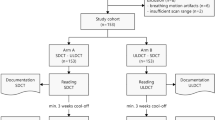Abstract
Purpose
Complex percutaneous interventions often require high radiation doses likely to produce skin radiation injuries. We assessed the methodology used to select patients with potential skin injuries in cardiac procedures and in need of clinical follow-up. We evaluated peak skin dose and clinical follow-up in a case of radiodermatitis produced during a total occlusion recanalization.
Materials and Methods
This prospective study followed CIRSE and ACC/AHA/SCAI recommendations for patient radiation dose management in interventional procedures carried out in a university hospital with a workload of 4200 interventional cardiac procedures per year. Patient dose reports were automatically transferred to a central database. Patients exceeding trigger levels for air kerma area product (500 Gy cm2) and cumulative skin dose (5 Gy) were counseled and underwent follow-up for early detection of skin injuries, with dermatologic support. The Ethical Committee and the Quality Assurance and Radiation Safety Committee approved the program.
Results
During 2010, a total of 13 patients (3.0/1,000 that year) received dose values exceeding trigger levels in the cardiovascular institute. Only one patient, who had undergone two consecutive procedures resulting in 970 Gy cm2 and 13.0 Gy as cumulative skin dose, showed signs of serious radiodermatitis that resolved in 3.7 months. The remaining patients did not manifest skin lesions during follow-up, and whenever patient examination was not feasible as part of the follow-up, neither patients nor families reported any skin injuries.
Conclusions
Peak skin dose calculation and close clinical follow-up were feasible and appropriate, with a moderate additional workload for the staff and satisfaction for the patient.





Similar content being viewed by others
References
International Commission on Radiological Protection (2000) ICRP Publication 85. Avoidance of radiation injuries from medical interventional procedures. Ann ICRP 30:7–67
Balter S, Schuler BA, Miller DL et al (2011) NCRP radiation dose management for fluoroscopically guided interventional medical procedures. National Council on Radiation Protection and Measurements. NCRP Report No. 168
Chambers CE, Fetterly K, Holzer R et al (2011) Radiation safety program for the cardiac catheterization laboratory. Cath and Card Interv 77:510–514
Levine GN, Bates ER, Blankenship JC et al; American College of Cardiology Foundation; American heart association task force on practice guidelines; Society for cardiovascular angiography and interventions (2011) 2011 ACCF/AHA/SCAI Guideline for percutaneous coronary intervention. A Report of the American College of Cardiology Foundation/American heart association task force on practice guidelines and the society for cardiovascular angiography and interventions. J Am Coll Cardiol 58:e44–e122
Hirshfeld JW Jr, Balter S, Brinker JA et al (2004) ACCF/AHA/HRS/SCAI clinical competence statement on physician knowledge to optimize patient safety and image quality in fluoroscopically guided invasive cardiovascular procedures. A report of the American College of Cardiology Foundation/American Heart Association/American College of Physicians Task Force on Clinical Competence and Training. J Am Coll Cardiol 4:2259–2282
Stecker MS, Balter S, Towbin RB et al (2009) SIR Safety and Health Committee; CIRSE Standards of Practice Committee. Guidelines for patient radiation dose management. J Vasc Interv Radiol 20(7 suppl):S263–S273
International Electrotechnical Commission (2010) Medical electrical equipment. Part 2-43. Particular requirements for the safety of X-ray equipment for interventional procedures. Report IEC 60601-2-43. Geneva, Switzerland: International Electrotechnical Commission
Balter S, Hopewell JW, Miller DL et al (2010) Fluoroscopically guided interventional procedures: a review of radiation effects on patients’ skin and hair. Radiology 254:326–341
Dehen J, Vilmer C, Humilière C et al (1999) Chronic radiodermatitis following cardiac catheterisation: a report of two cases and a brief review of the literature. Heart 81:308
Shope TB (1996) Radiation-induced skin injuries from fluoroscopy. Radiographics 16:1195–1199
Vano E, Arranz L, Sastre JM et al (1998) Dosimetric and radiation protection considerations based on some cases of patient skin injuries in interventional cardiology. Br J Radiol 71:510–516
Wagner LK, Eifel PJ, Geise RA (1994) Potential biological effects following high X-ray dose interventional procedures. J Vasc Interv Radiol 5:71–84
Koenig TR, Mettler FA, Wagner LK (2001) Skin injuries from fluoroscopically guided procedures: part 2, review of 73 cases and recommendations for minimizing dose delivered to patient. AJR Am J Roentgenol 177:13–20
Fernandez-Soto JM, Vano E, Guibelalde E (2011) Spanish experience in education and training in radiation protection in medicine. Radiat Prot Dosimetry 147:338–342
Ten JI, Fernandez JM, Vano E (2011) Automatic management system for dose parameters in interventional radiology and cardiology. Radiat Prot Dosimetry 147:325–328
Galassi AR, Tomasello SD, Reifart N et al (2011) In-hospital outcomes of percutaneous coronary intervention in patients with chronic total occlusion: insights from the ERCTO (European registry of chronic total occlusion) registry. EuroIntervention 7:472–479
Rajadhyaksha M, Grossman M, Esterowitz D et al (1995) In vivo confocal scanning laser microscopy of human skin: melanin provides strong contrast. J Invest Dermatol 104:852–946
Rajadhyaksha M, Gonzalez S, Zavislan JM et al (1999) In vivo confocal scanning laser microscopy of human skin II: advances in instrumentation and comparison with histology. J Invest Dermatol 113:293–303
Acknowledgments
Partially supported by the Ministry of Science and Innovation (Grant SAF2009-10485).
Conflict of interest
The authors declare that they have no conflict of interest.
Author information
Authors and Affiliations
Corresponding author
Rights and permissions
About this article
Cite this article
Vano, E., Escaned, J., Vano-Galvan, S. et al. Importance of a Patient Dosimetry and Clinical Follow-up Program in the Detection of Radiodermatitis After Long Percutaneous Coronary Interventions. Cardiovasc Intervent Radiol 36, 330–337 (2013). https://doi.org/10.1007/s00270-012-0397-x
Received:
Accepted:
Published:
Issue Date:
DOI: https://doi.org/10.1007/s00270-012-0397-x




